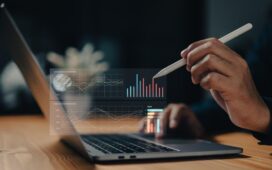For decades, the Bloomberg Terminal has been the gold standard for traders and investors seeking detailed financial data. With its comprehensive database, real-time information, and analytical tools, Bloomberg provided subscribers with everything from stock prices to economic forecasts. However, as the financial world evolves, so do the tools used to navigate it. ChainTrade.ai represents the next generation of market intelligence, leveraging artificial intelligence (AI) to provide insights and connections that the Bloomberg Terminal, despite its strengths, cannot.
The Bloomberg Terminal: A Trusted Tool for Traders
The Bloomberg Terminal, launched in the 1980s, has long been a crucial tool for institutional investors and traders. It offers real-time market data, financial news, analytics, and proprietary tools designed to help investors track prices, perform technical analysis, and make informed decisions. However, despite its rich history and usefulness, the Bloomberg Terminal has its limitations, especially in the context of how information is processed and delivered.
With a Bloomberg subscription, traders receive access to vast amounts of raw data. This includes everything from stock prices and bond yields to economic indicators and news headlines. While this data is undoubtedly valuable, interpreting and applying it in a fast-moving market can be overwhelming, even for seasoned investors. Bloomberg provides the information, but it is still up to the trader to make connections and identify trends.
The ChainTrade.ai Advantage: AI-Driven Insights
While Bloomberg offers a vast array of data points, ChainTrade.ai takes things a step further by using AI to interpret this data in real time. The key difference between the two platforms lies in ChainTrade.ai’s ability to process massive amounts of information and make connections that are difficult, if not impossible, for a human trader—or even Bloomberg’s system—to uncover on its own.
For instance, ChainTrade.ai doesn’t just report market data—it analyzes patterns across various markets (stocks, bonds, ETFs, commodities, and more) and identifies relationships between them that may not be immediately obvious. This allows ChainTrade.ai to offer actionable insights rather than just raw data. By continuously scanning multiple markets and applying machine learning algorithms, ChainTrade.ai’s AI can detect subtle shifts that might indicate future price movements or emerging trends. This is a key advantage over Bloomberg, which relies more on human interpretation of data.
Connecting the Dots: AI’s Role in Identifying Opportunities
One of ChainTrade.ai’s biggest advantages is its ability to draw connections across seemingly unrelated data sets. For example, imagine a scenario where rising oil prices are impacting the transportation sector. ChainTrade.ai’s AI could detect this trend and recommend reducing exposure to transportation stocks while suggesting increased investment in energy-related assets like oil or commodity ETFs. This kind of nuanced recommendation comes from the platform’s ability to interpret vast amounts of data and link cause-and-effect relationships in real time—something the Bloomberg Terminal cannot do automatically.
While Bloomberg might provide an investor with the raw data they need to see rising oil prices and falling transportation stocks, it would be up to the trader to manually connect those dots. ChainTrade.ai’s AI does the work of making these connections automatically, ensuring traders don’t miss opportunities due to the overwhelming volume of data.
Going Beyond Data with Predictive Capabilities
Another key distinction between ChainTrade.ai and Bloomberg is the predictive capability of AI. While Bloomberg excels at providing historical data and real-time quotes, it doesn’t predict market trends in the same way ChainTrade.ai does. ChainTrade.ai’s AI algorithms analyze historical trends alongside real-time data, using machine learning to forecast future movements.
For example, if a particular stock has historically risen following certain macroeconomic announcements—such as interest rate cuts—ChainTrade.ai’s AI will factor this into its analysis, offering predictions about how that stock might behave in similar future circumstances. This predictive ability gives traders using ChainTrade.ai a significant edge, as they are not only reacting to current data but also anticipating future movements based on patterns that the AI has identified.
Bloomberg, by contrast, provides access to detailed historical data but does not offer the same level of automated forecasting or personalized recommendations. Traders using Bloomberg still need to manually analyze trends and predict future movements themselves.
AI-Powered Research: From Insights to Action
The Bloomberg Terminal is renowned for its ability to provide financial news and research from top analysts around the world. However, much of this research requires users to sift through reports, compare different analysts’ opinions, and come to their own conclusions. ChainTrade.ai, on the other hand, automates this process by using AI to parse news, earnings reports, and social sentiment, delivering concise, actionable insights directly to the trader.
For instance, while Bloomberg might present several analyst reports on a particular stock, ChainTrade.ai’s AI can synthesize the data, provide a summary of key points, and offer recommendations based on its own analysis of broader market trends. This eliminates the need for traders to manually sort through multiple sources of information, saving time and allowing for quicker, more informed decisions.
Real-Time Adaptation vs. Static Information
Another difference between ChainTrade.ai and the Bloomberg Terminal is the speed and adaptability of the information provided. While Bloomberg delivers real-time data feeds, it relies heavily on the trader’s ability to interpret and act on that data manually. ChainTrade.ai’s AI adapts in real time, continuously analyzing incoming data and making adjustments to its recommendations as market conditions change.
For example, if a significant event occurs—such as an unexpected economic report or political development—the AI will immediately reassess the market and provide new recommendations based on its updated analysis. This dynamic approach allows traders to stay ahead of market shifts, while Bloomberg users must manually adjust their strategies as they digest new information.
Conclusion: ChainTrade.ai’s AI Powers the Future of Market Intelligence
The Bloomberg Terminal has long been a cornerstone for traders and institutional investors seeking real-time market data and financial information. However, as AI technology evolves, platforms like ChainTrade.ai are beginning to surpass traditional data services by offering deeper insights, predictive analysis, and automated recommendations. By making connections that traders might miss and adapting in real time to market changes, ChainTrade.ai empowers users to act quickly and confidently in a rapidly shifting financial landscape. As the future of market intelligence moves toward AI-driven platforms, ChainTrade.ai represents the next step in empowering traders with smarter, more actionable data.













